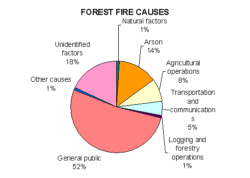Sadly, Forest Fires have become a seasonal problem. This is even sadder since most fires are caused by humans. You would think that tis means forest fires would be more preventable, but Smokey would disagree.
For some forests, like lodgepole pine, fires can be a healthy event. The pinecones on Lodgepole pines explodes when heated and scatters future seeds. This happens in moderate fires. Huge, hot fires simply burn the seeds up to.
One Spring, I turkey hunted an area that had burned. The first thing that I noticed was the variety of small sprouts, shoots, and grasses. Intermixed among the plants were turkey droppings. I set up along an edge nearby that had not burned. My decoys were in the burned area. Without much calling, several birds came to visit. One shot later and a hefty Gobbler was in the bag.
Fire is, or was, a natural ecological event. Native peoples routinely would ignite old forests and grasslands. The following season meant better hunting, grazing, and diversity. Yellowstone Park had a no firefighting policy for decades until fires almost burned the entire park back in the 1990’s.
After a fire, areas of dry brush and timber are turned in ash. Seeds are exposed to take root, diseased timber is eliminated along with harmful beetles, insects, and bacteria. Nutrients and healthy soils can be the result. Too much fire that is too hot simply destroys everything. 
Reseeding and replanting help but forests take a lifetime to return. 60-80 years is a fast return. Other trees like ponderosa pines and other ancient species take hundreds of years to return.
Fires today are more damaging, and harsh than ever. The fire retardants dumped onto the soil have a negative impact. Despite the challenges, wildlife quickly returns. Sunlight can now reach the exposed, unshaded forest floors and invite new plants to grow.
Another bonus after fires is the number of mushrooms and berries that welcome the sun and enriched soils. Big Game critters also will migrate into these areas to feast on the new and abundant grasses.
Nature is amazing and can quickly recover from fires. Not everything usually burns. Some edges and forest fringes will remain. Some trees are scorched but not killed. Small islands of undisturbed areas will provide future deeds, cones, and habitat. This is where you hunt for the more concentrated populations.
Big game critters still have great eyesight, smell, and survival instincts. They just need to up their game to survive in more open areas. For hunters this means more long-range spotting, stalking, and shooting.
During some down time, plant some pinecones, scatter some seed pods, and place rocks in drainage spots that could erode easily. Managing and restoring your favorite hunting areas is smart and welcomed.
Great hunting can again arise from the ashes!
Montana Grant